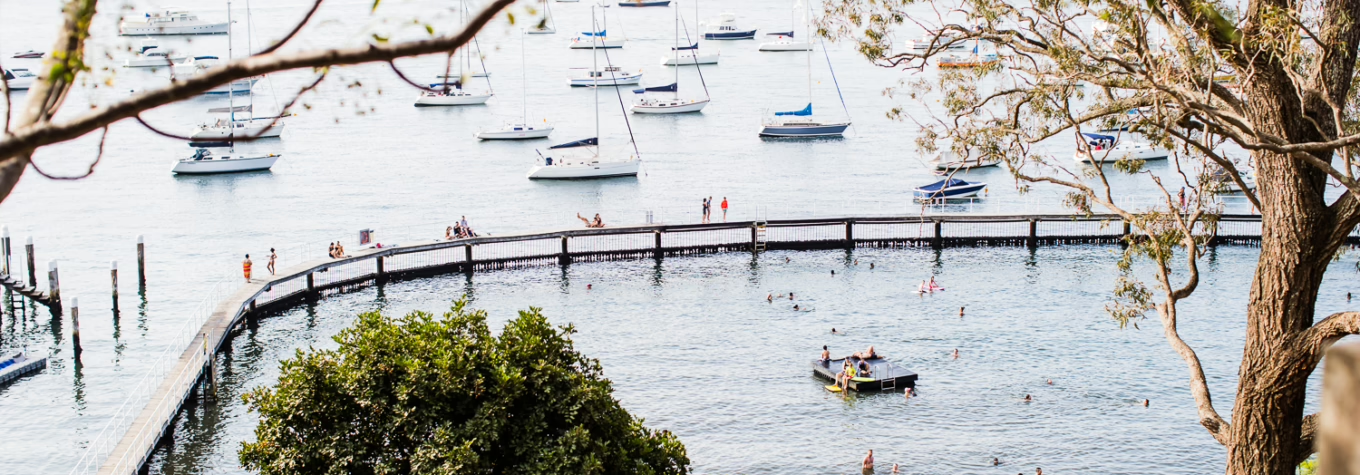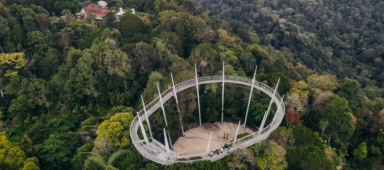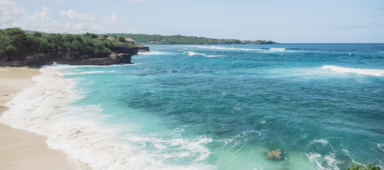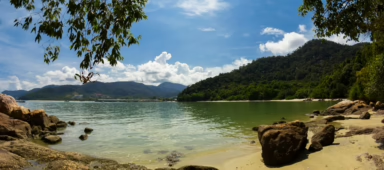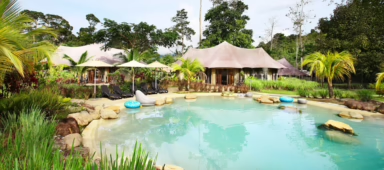They may not be as famous, but ocean pools are as ‘Sydney’ as the harbour bridge
You can sum up Sydney in summer with a series of conflicting sensations. There’s the shriek of cockatoos over the low rumble of thunder. The warm breeze laced with the unexpected scent of frangipani. And the feeling of hot sandstone under your feet before you jump into an ocean pool.
When I arrive at Malabar Beach, I descend a rickety set of wooden stairs. I shuck off my sandals and inch myself over the edge. Then I tread water, taking in the dazzling blue of the Pacific and the cliffs of Long Bay, unchanged since the Jurassic period. A black-and-white striped fish, the Australian mado, darts between my knees. For a moment, the chaos of the city – traffic, dinner plans, deadlines – could be a planet away.
Malabar Ocean Pool overlooks Malabar, a beachside suburb a thirty-minute drive southeast of the city centre. It unfolds across a rocky outcrop pocked with shellfish middens, a trace of the Indigenous Bidjigal and Gadigal clans that once hunted and fished on this headland. But like the 34 other ocean pools that crisscross Sydney’s coastline – from Palm Beach in the north to Cronulla in the south – this lopsided 30m-long rectangle seems to exist in another dimension. It occupies a place between land and sea.
Everyone knows Bondi Icebergs, that turquoise lozenge that regularly surfaces on Instagram feeds, surrounded by the washing-machine churn of the ocean. These less-famous structures were built from the 1890s, when recreation and leisure was centred around the harbour.
They accommodated colonial swimmers who feared the roiling East Australian Current. Later, they employed workers who found themselves adrift during the Great Depression. Towards the middle of the century, Australia became increasingly obsessed with backyard swimming and suburban aquatic centres.
No new ocean pools have been built in the city since the 1960s. But these days, Sydneysiders are once again taking pride in these spaces, which possess an undeniable visual beauty – one that resonates with an era increasingly dominated by images. This pride is contagious; plans for ocean pools are in the works in the towns of Ballina and Port Macquarie as well as in the states of Western Australia and South Australia. But these spaces, carved into Sydney’s craggy coastline, remain a defining element of the Harbour City.
They reflect Sydneysiders’ primal relationship with the landscape. They also play a starring role in the city’s life.
Nicole Larkin is a Sydney-based architect, designer and artist who has made it her mission to document the ocean pools scattered up and down the coast through her project the Wild Edge. Nicole says that although Sydney’s ocean pools, which often occupy natural rock platforms and ancient coves, are humble, they are a compelling part of the city’s identity. Part of the appeal, for her, is the fact that these spaces are accessible. Often, they cost nothing to visit.
“We have an ocean pool at almost every beach and they are simple structures that touch on Sydney’s relationship with the water,” Nicole says with a smile. “Ocean pools were a safer alternative for kids, older people, people who aren’t confident. They allow you to enter the ocean through a protected space.”
For generations of Sydney women, this sanctuary is McIver’s in Coogee, Australia’s last ladies-only ocean baths. The baths were built in 1876 by Rose and Robert McIver for their young daughter who was refused entry to a nearby swim club. A relic from the era of gender-segregated swimming, it is a seaside oasis encircled by scrubby bushland. Here, for a two-dollar donation, you can sunbathe on the grass while grandmothers in bathing caps swim morning laps and girls in hijabs laugh and splash, dipping their toes in the water.
On a clear afternoon, you can be buffeted by the current, salt fizzing against your skin. You can float on your back, sea and sky and cliffs blurring together, completely unselfconscious and free.
Caroline Clements, co-author of Places We Swim is currently researching Places We Swim Sydney, a chronicle of Sydney’s iconic swimming spots along with Dillon Seitchik-Reardon. Caroline, a Bondi local, has travelled Australia, exploring the country’s beaches, lakes and gorges. She says that Sydney’s ocean and harbour pools are social spaces, hubs for the communities that live across the city’s sprawling geography. Caroline says this sets them apart.
“A place like Bronte Baths is really iconic, a community space,” she grins. “It’s a place where people come to meet and chat. A lot of the older women there are quite glamorous. They bob around in the water, they take showers.” Caroline goes on to explain what an active city Sydney is and how a lot of people factor in time for the water before work, pointing out that if you visit Bronte Baths at 6am, you’ll spot hundreds of people.
Ocean pools are only one type of community space in Sydney. For Sydneysiders that live along the bays and coves that comprise the city’s famous harbour, there are few experiences as sacred as taking a dip in a harbour bath. Caroline vouches for Northbridge Baths on the city’s North Shore – “It’s half an hour from the city and surrounded by gum trees.” – along with Murray Rose Pool, a much-loved harbour bath in Double Bay named after a six-time Olympic medallist.
At Murray Rose Pool on a 40-degree day, I watched children dive off the pontoons while yachts drifted on the glittering blue-green water. Mothers covered their toddlers with sunscreen and friends convened in the kiosk on the hill, drinking mango frappes. Post-swim, I let the sun dry my skin, circling the wraparound jetty.
“Excuse me, is the water cold?” asked a teenage boy with freckles. I gave him my verdict.
“Harbour pools were built to make the most of the landscape,” Caroline adds. “You pick a place where you know people, feel comfortable. Everyone has a connection to a local spot.”

Julie Isbill is the founder of Bold & Beautiful, a squad that meets each day at 7am to swim 1.5km in Cabbage Tree Bay between Shelly Beach and Manly. She believes that Sydney’s ocean pools blend the human scale of the swimming pool with the unknown powers of the ocean. This can cement our relationship with the wilderness. It’s also a reminder to take care of it.
“Rock pools are the best of both worlds, a beautiful amalgamation of pool and ocean,” Julie explains. “In Cabbage Tree Bay, we’ve swum with dolphins and whales and we have turtles on occasion. Swimmers can have confidence in the fact that we can live in harmony [with marine species]. One of the Bold & Beautiful swimmers is regrowing the sea grass which is an important part of the ecological system. People really take an interest. To say they are passionate would be an understatement.”

Nicole believes that Sydney’s ocean pools are experiencing a watershed moment. Climate change will bring bigger storms and rising oceans. But part of the conversation about protecting ocean pools, she says, involves thinking about their original purpose – and bringing their pleasures to a wider swathe of the community.
“Ocean pools tie into the bigger picture of climate change adaptation, which is about how we protect the coastline,” she says. “But it’s also about asking the community to think about ocean pools in a really considered way. We have this big affinity with the coastline, it’s a place we dwell. But how can we ensure people with wheelchairs can use them, that people with vision impairment get into the water? How can we turn ocean pools into something the whole community can use?” Nicole adds. “I see the future as an opportunity to do something really amazing.”
Malaysia Airlines flies 14 times weekly between Kuala Lumpur and Sydney. To book a flight, visit malaysiaairlines.com.
